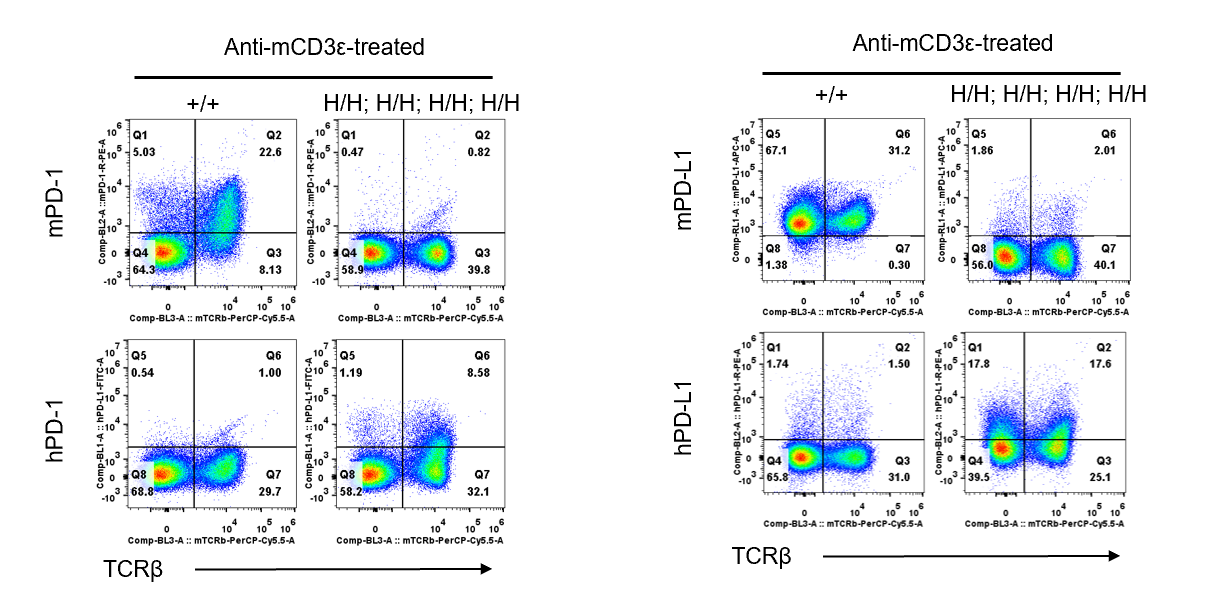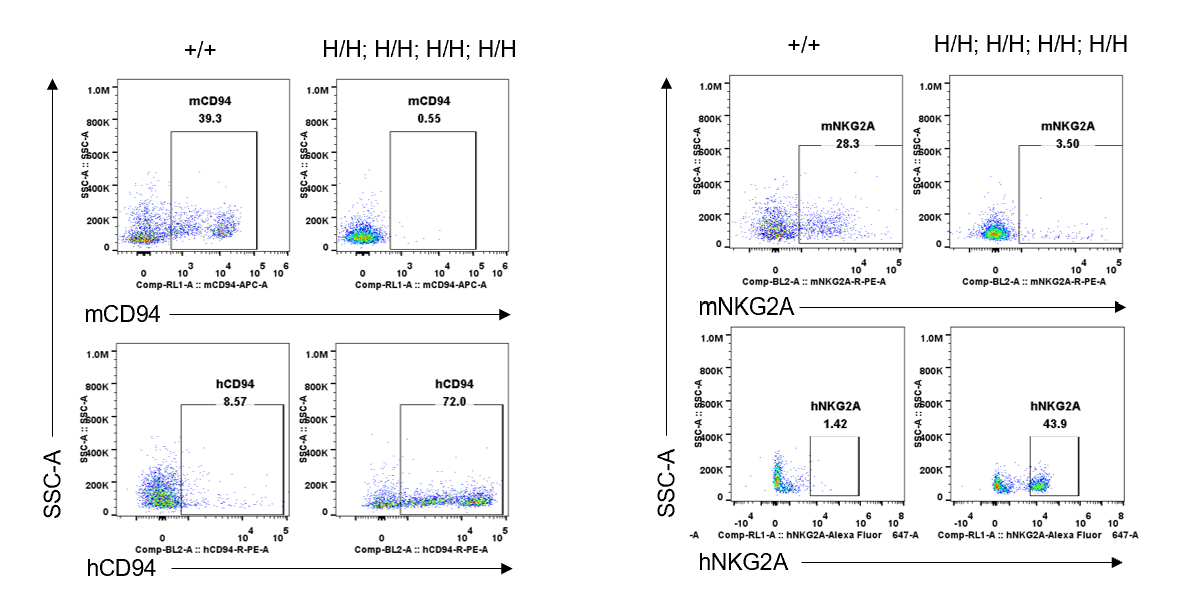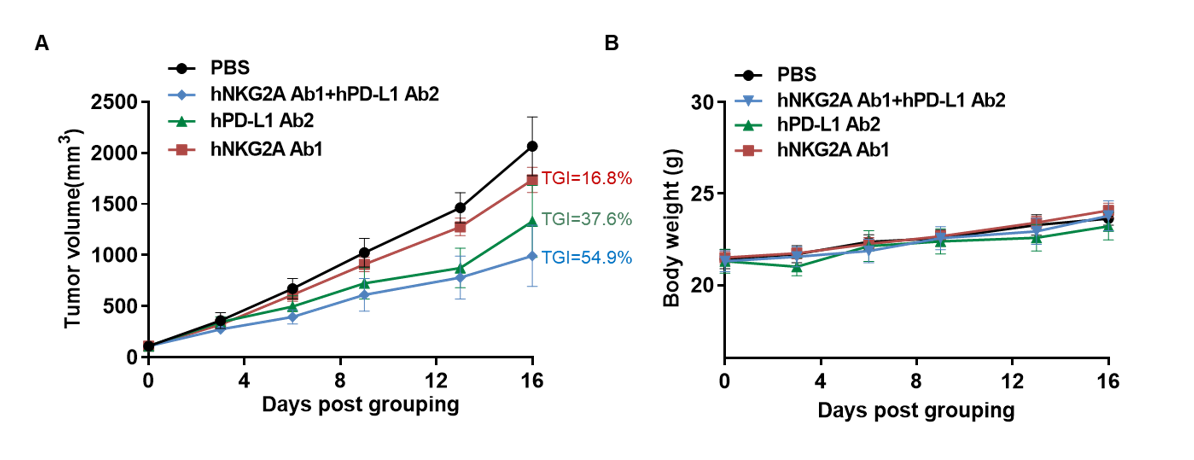Basic Information
-
Targeting strategy

-
Gene targeting strategy for B-hPD-1/hPD-L1/hCD94/hNKG2A mice.
The exons 3~6 of mouse Cd94 gene that encode the extracellular domain were replaced by human CD94 exons 3~6 in B-hPD-1/hPD-L1/hCD94/hNKG2A mice;
The exons 2~6 of mouse Nkg2a gene that encode the extracellular domain were replaced by human NKG2A exons 2~6 in B-hPD-1/hPD-L1/hCD94/hNKG2A mice;
The exon 2 of mouse Pd-1 gene that encodes the IgV domain was replaced by human PD-1 exon 2 in B-hPD-1/hPD-L1/hCD94/hNKG2A mice;
The exon 3 of mouse Pd-l1 gene that encodes the IgV domain was replaced by human PD-L1 exon 3 in B-hPD-1/hPD-L1/hCD94/hNKG2A mice.
This mouse model was developed by breeding the B-hPD-1/hPD-L1 mice and the B-hCD94/hNKG2A mice
-
Protein expression analysis of PD-1/PD-L1 in T cell

-

Strain specific PD1 and PD-L1 expression analysis in homozygous B-hPD-1/hPD-L1/hCD94/hNKG2A mice by flow cytometry.
Splenocytes were collected from wild type mice (+/+) and homozygous B-hPD-1/hPD-L1/hCD94/hNKG2A mice (H/H; H/H; H/H; H/H) stimulated with anti-CD3ε in vivo , and analyzed by flow cytometry with species-specific anti-PD-1 and anti-PD-L1 antibodies. Mouse PD-1 and PD-L1 were exclusively detectable in wild type mice. Human PD-1 and PD-L1 were exclusively detectable in homozygous B-hPD-1/hPD-L1/hCD94/hNKG2A mice but not in wild type mice.
-
Protein expression analysis of NKG2A/CD94 in NK cell

-

Strain specific CD94 and NKG2A expression analysis in homozygous B-hPD-1/hPD-L1/hCD94/hNKG2A mice by flow cytometry.
Splenocytes were collected from wild type mice (+/+) and homozygous B-hPD-1/hPD-L1/hCD94/hNKG2A mice (H/H; H/H; H/H; H/H), and analyzed by flow cytometry with species-specific CD94 or NKG2A antibody. Mouse CD94 and NKG2A were detectable in wild type mice. Human CD94 and NKG2A were exclusively detectable in homozygous B-hPD-1/hPD-L1/hCD94/hNKG2A mice but not wild type mice. (Monalizumab (in house) was used to detect the human NKG2A protein expression)
-
Protein expression analysis of NKG2A/CD94 in activated CD8+ T cells

-

Strain specific CD94 and NKG2A expression analysis in homozygous B-hPD-1/hPD-L1/hCD94/hNKG2A mice by flow cytometry.
Splenocytes were collected from wild type mice and homozygous B-hPD-1/hPD-L1/hCD94/hNKG2A mice (H/H; H/H; H/H; H/H), and analyzed by flow cytometry with species-specific CD94 or NKG2A antibody. Spleen cells were stimulated for the 5 days coated with 5 μg/ml anti-TCRβ mAb before analysis. Mouse CD94 and NKG2A were detectable in wild type mice. Human CD94 and NKG2A were exclusively detectable in homozygous B-hPD-1/hPD-L1/hCD94/hNKG2A mice but not wild type mice. (Monalizumab (in house) was used to detect the human NKG2A expression)
-
Combination therapy of anti-human PD-L1 antibody and anti-human NKG2A antibody

-

Antitumor activity of anti-human NKG2A antibodies and anti-human PD-L1 antibodies in B-hPD-1/hPDL1/hCD94/hNKG2A mice. (A) Anti-human NKG2A antibodies (in house) combined with anti-human PD-L1 antibodies (in house) inhibited B-hHLA-E plus/hPD-L1 MC38 tumor growth in B-hPD-1/hPDL1/hCD94/hNKG2A mice. Murine colon cancer B-hHLA-E plus/hPD-L1 MC38 cells were subcutaneously implanted into homozygous B-hPD-1/hPDL1/hCD94/hNKG2A (female, 7-8-week-old, n=6). Mice were grouped when tumor volume reached approximately 100 mm3, at which time they were treated with anti-hNKG2A Ab1 and anti-hPD-L1 Ab2. (B) Body weight changes during treatment. As shown in panel A, combination of hPD-L1 and hNKG2A antibodies were more efficacious in controlling tumor growth in B-hPD-1/hPDL1/hCD94/hNKG2A mice. B-hPD-1/hPDL1/hCD94/hNKG2A mice is a powerful preclinical model for in vivo evaluation of anti-human PD-L1 and NKG2A antibodies. Values are expressed as mean ± SEM.


